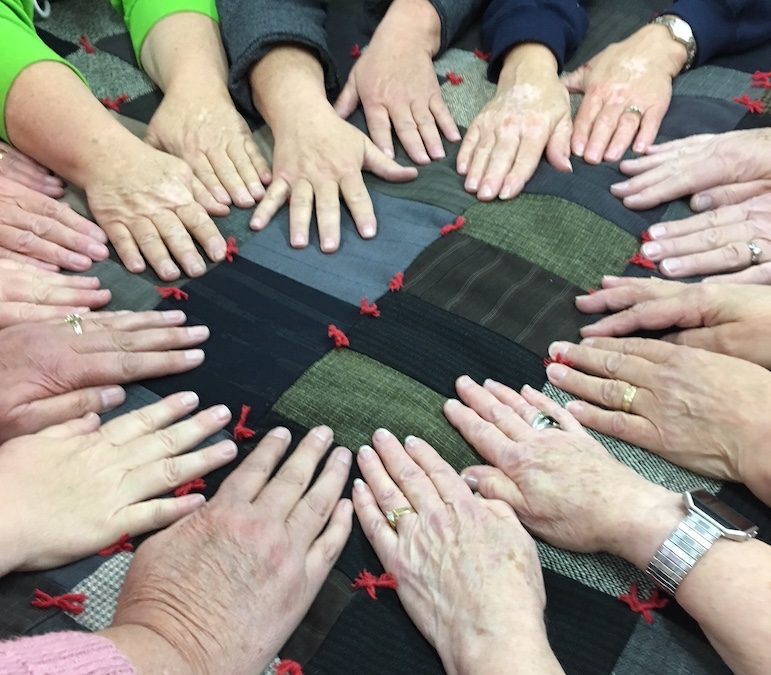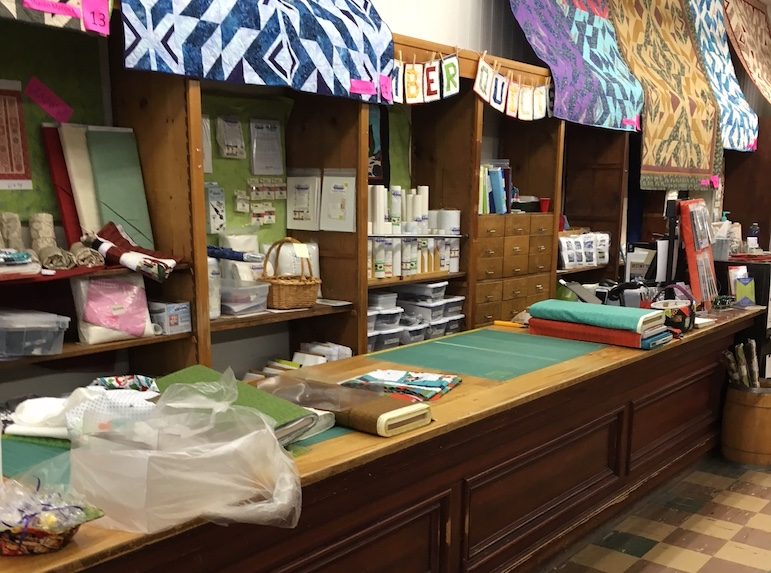Many hands help restore family heirloom quilt
|
Many dedicated hands and hearts working together: that’s what makes a quilt.
There are solo quilts that are masterpieces of patience, fabulous fabrics, profound concentration and talent. They are woven, ironed, sewed, appliqued and painstakingly pieced together, forming storyboards of singular artistic beauty.
But, there is a conspiracy, or maybe a non-guild union, or a rite of passage or maybe even a confederacy of actors — called quilters — from which every solo quilter has learned the artistic craft.
Maybe a single pair of hands can learn to quilt fabric — functional art — alone. But most quilter’s hands have touched hundreds of quilts before going solo. Examined seams. Studied stitching. Felt for texture and eyed color matches. Composition.
The ears of those solo hands had listened to stories about a sister-in-law’s uncle’s neighbor who had made quilts. How she did stuff. What she used. Hand-stitching style. Quilters borrow ideas and processes through hand-me-down stories.

Larry Olson
The vintage-look backing on Lin Olson’s project. It resembles very closely the original backing, which had to be discarded.
Some quilts hang on walls. Some warm old folks’ laps. Some become Christmas or birthday presents to spread out on a bed for youngsters to sleep and stay warm under. Drool on. Get turned into tents for sleepovers. Some quilts rest out the heat of summer in cedar chests, folded to absorb warmth to release during cold winter months. Some quilts mold, mildew and become feasts for uneducated, yet needy, mice.
That’s when quilter’s hands adapt from being fresh fabric creators to conscientious and meticulous restorers. These hands attempt to resurrect a functional project from the past and repurpose it for the current or next generation. Maybe these women, self-branded as quilters, just need to keep their hands busy. Idle hands are the devil’s workshop stuff. Maybe, it’s much more.
The quilt discussed here, and restored by Lin Olson (and other hands), can only be described as undeniably ugly. The material was hideously dark. Closing in on 90 years old, the quilt had been stitched together by Norwegian women in Battle Lake, Minn., circa 1930.
Pieced from usable parts of worn-out old men’s wool suits, women’s long skirts and topcoats from the First World War era, the quilt was drab, dark and anything but soft to the touch. It wasn’t square: trapezoidal at best. Seams of pants and skirts were never separated, just cut up into usable squares. It was a dull variety of dark plain colors cut up to warm the function of sleeping. Utilitarian.
The quilt was to be a birthday present for Warren Olson; an 8-year-old boy who grew up to be Lin Olson’s father-in-law. Whichever of Warren’s four brothers he was forced to share a bed with, in an unheated upstairs bedroom, would also benefit.
One can only imagine the broken-English stories that were told with needle and thread in hand as these women stitched away; the laughter and tears shared and guided by the passionate resolve of those collected hands and hearts to quilt.
Over the years, to add to the dark tones of the fabric and inherent ugliness of the quilt, it became filthy dirty. Decades after Warren was grown, the quilt’s life had been relegated to being a back-up blanket at the family cabin. When more than normal company visited, or there was a stiff chill in the air, the quilt would make an appearance.The consideration stage of restoring the quilt began about 10 years ago. How to start was the primary question. Was it even worth the effort to restore was a question that plagued the plan from the beginning. Finally, Lin made the decision to start and the learning process began.
Many of the squares were completely worn out and would need to be replaced or covered over. Large sections of the quilt were relatively intact but still needed to be cleaned, darned, patched and refit. The old backing was stained beyond cleaning and, as a cure, she used a seam ripper to cut it off and throw it away, then replaced it with new vintage backing material.
The batting, which was ancient pulled and carded wool, was rotted, matted and worthless. It was dumpster bound as well.
Washed and rinsed in a bathtub with Woolite and cold water, the top piece shed the filth of years past. The pieces required four washings and even more rinses before the water was clear and the smell of the material was that of wet wool — not mildew, wood smoke and mud.

Larry Olson
Little Timber Quilts and Candy, where the ugly quilt gained respect and insight into methods for repair.
Many new hands and hearts came into play with the quilt when it was brought to Little Timber Quilts (ltquilts.com) in Big Timber, Mont. The sharing of ideas, by learned hands in Big Timber, had begun.
These fellow quilters held and carefully inspected the pieces to describe their ideas and experiences on how to proceed with repairs. New vintage-look backing material was chosen and purchased. A type of wool batting and the required wool binding material was purchased as well. Thread by the mile and wool yarn by the skein found its way onto Lin’s Discover Card.
Replacement pieces for damaged squares were cut from 1970s and 1980s Pendleton wool shirts. For some reason, these perfectly good shirts had shrunk over the years and no longer fit Lin’s husband. Interspersed between the cleaned original pieces, the new wool pieces were cut to fit. The top began to take shape with a newish look and luster.
The backing, edge binding and yarn top-tying processes were performed in the appropriate reconstruction stages and methods. Each stage was sanctioned with a visit to Little Timber Quilts for reassurance, experienced sewing input and the touches of fellow quilters.
Now, as the completed and restored quilt lies atop the bed in the Olsons’ guest bedroom, it is still hard to be called beautiful. In all honesty, it isn’t as ugly. It’s fresh to the touch. With each touch and flow of the hand across the top, you can feel the hearts and hands of the many quilters who added care to the finished product.
If you shut your eyes, gather a handful of the quilt in your hands, draw it to your nose for a sniff — and then listen, carefully — you can hear the stories that are sewn into the quilt from across many years and from many, many hands.
Larry Olson is a retired librarian who lives with his beautiful wife, Lin, in Big Timber. He is mostly a happy guy.







